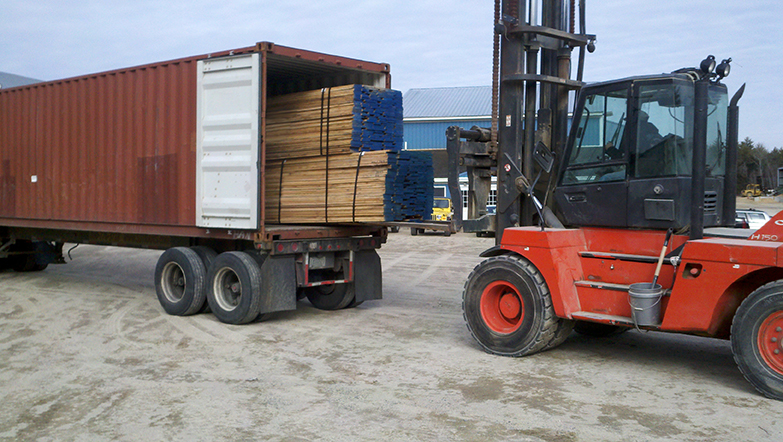In recent months, the required implementation of Electronic Logging Devices (ELDs) in fleet trucks has been on the minds of both suppliers and customers across many industries. The change to ELD as a standard has certainly introduced some new challenges for the hardwood lumber industry.
How Will the New Trucking Regulations Affect Hardwood Lumber?

What are the Requirements of the New ELD Rule?
According to the American Transportation Research Institute, one of the biggest challenges in trucking this year is the new requirement by the Federal Motor Carrier Safety Administration (FMCSA), effective as of December 18, 2017. The new rule requires drivers to use electronic logging devices instead of paper logs. ELDs monitor duration of engine operation and mileage driven, among other information.
Federal hours-of-service regulations require that drivers may drive no more than 11 hours a day and they must have ten consecutive hours off between workdays and ELDs are now required to ensure compliance with these rules.
Federal hours-of-service regulations require that drivers may drive no more than 11 hours a day and they must have ten consecutive hours off between workdays and ELDs are now required to ensure compliance with these rules.
Challenges of ELD Requirements
The introduction of ELDs represent some challenges for both the company and driver.
Cost: ELD installations are a significant cost for fleets.
Learning Curve: Understanding and operating the new equipment while on the road can be difficult.
Aging Workforce / Driver Shortage: There is concern that asking an aging workforce to use new technology will nudge an aging workforce out of the occupation. This would likely exacerbate the driver shortage already facing the trucking industry.
Loss of Productivity: Regulations may reduce driving hours for some compared to the previous status quo.
Longer Lead Times: With a continued driver shortage and stricter daily driving hours, deliveries are likely to take longer, especially as companies and drivers adjust to these new systems.
With ELDs, idling time counts as time in service, so if drivers have to wait to unload or pick up, they’ll have less time to drive before they’re required to take a ten-hour break. Shippers are still working to adjust to carefully planned delivery appointment schedules to avoid paying extra for driver detention.
Cost: ELD installations are a significant cost for fleets.
Learning Curve: Understanding and operating the new equipment while on the road can be difficult.
Aging Workforce / Driver Shortage: There is concern that asking an aging workforce to use new technology will nudge an aging workforce out of the occupation. This would likely exacerbate the driver shortage already facing the trucking industry.
Loss of Productivity: Regulations may reduce driving hours for some compared to the previous status quo.
Longer Lead Times: With a continued driver shortage and stricter daily driving hours, deliveries are likely to take longer, especially as companies and drivers adjust to these new systems.
With ELDs, idling time counts as time in service, so if drivers have to wait to unload or pick up, they’ll have less time to drive before they’re required to take a ten-hour break. Shippers are still working to adjust to carefully planned delivery appointment schedules to avoid paying extra for driver detention.
What Does All of This Mean for Lumber Shipments?
In the short term, hardwood lumber is moving slower. Whether a company is running their own fleet or using independent drivers, everyone is still adjusting to the changes that accompany the new ELD requirements. In addition, we are seeing trucking costs increase as low trucking availability works against a learning curve for everyone involved.
Over time, this should lead to positive opportunities for those who choose to look for ways to use ELDs to work smarter and more efficiently over time. In the meantime, no matter your role in the hardwood lumber industry, have patience while we all learn together.
Over time, this should lead to positive opportunities for those who choose to look for ways to use ELDs to work smarter and more efficiently over time. In the meantime, no matter your role in the hardwood lumber industry, have patience while we all learn together.
An Added Challenge: Driver Shortages
In the American Transportation Research Institute’s annual industry issues report for 2017, driver shortage topped the list of critical issues facing the industry for the first time since 2006. The trucking industry has been coping with a driver shortage for the last 15 years, and the numbers are getting worse. The industry was approximately 50,000 drivers short in 2017, and that is expected to increase to a shortage of 174,000 by 2026. An aging population of truckers is the primary reason for this shortage.
According to the Bureau of Labor Statistics, the average age of a commercial truck driver in the United States is 55 years old. To keep up with demand and replace a workforce nearing retirement, the industry will need to hire 898,000 drivers over the next decade. Most trucking companies report that they are getting plenty of applicants, but only a small percentage of those applicants have the required experience and qualifications necessary to meet safety standards.
According to the Bureau of Labor Statistics, the average age of a commercial truck driver in the United States is 55 years old. To keep up with demand and replace a workforce nearing retirement, the industry will need to hire 898,000 drivers over the next decade. Most trucking companies report that they are getting plenty of applicants, but only a small percentage of those applicants have the required experience and qualifications necessary to meet safety standards.